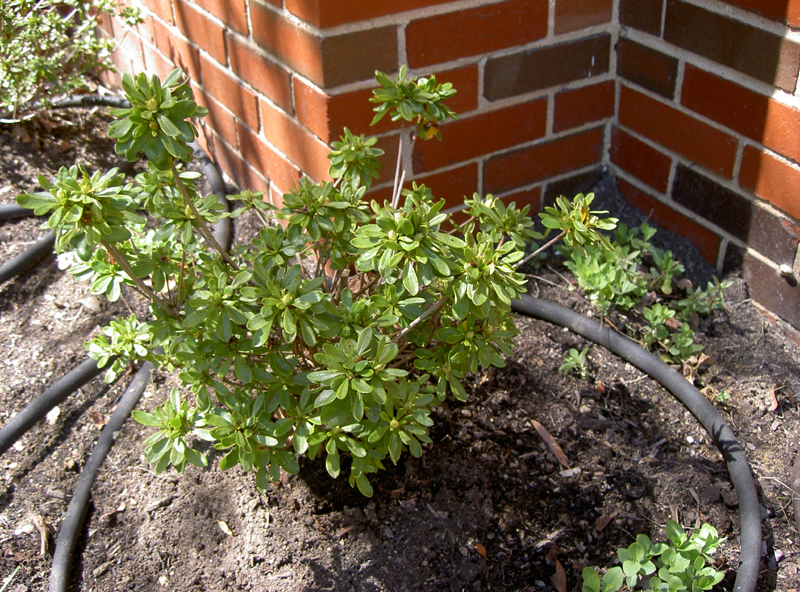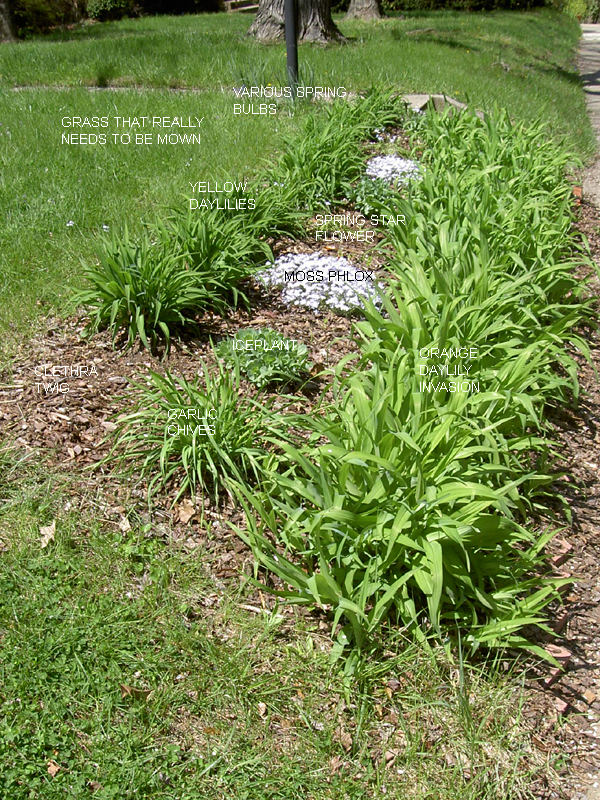
Grape hyacinths in the crocus bed, with super-long grass in the background.
Now that everyone’s tulips are in bloom, I think it’s safe to say I won’t be getting much out of the bulb transplants in the little bed around the lightpost. I know that you’re not supposed to move them in the spring (for this reason) but I was quite sure I’d forget where they were if I waited. Penance is waiting until next year to see what kind of narcissus I unearthed in the backyard last spring. In the meantime, the perky little grape hyacinth that I love and everyone else finds a total nuisance did bloom and will no doubt spread their invasive seeds back into the yard via their friends the birds. That’s nature for you.

Little white azalea in its new spot by the chimney, with creeping phlox in the background.
In a rare feat of perfect timing, we moved the wee white azaleas into their new spot (on the south side of the house by the chimney) just in time for them to enjoy several days of steady soaking rain. I’ve left the drip hose there because I’m lazy, but I only used it for a half hour after we put them in place. The phlox, a native type that I’ve forgotten the name of, are already happier there than they were all last summer; they pretty much baked nigh unto death in the place where I’d had them. What can I say, I thought (1) the foundation bed was shady and (2) the azaleas would grow larger and shade them. I’ve atoned by moving them, and it looks like I’ll get several flowers on each plant, which is a pleasant bonus.

The star flowers perked up right away, and loved all the rain we got this week.

This is the perked up version of the clethra twig I (hope I) kept alive inside all winter.
The rain was also good for all the plants I moved around into and out of the front bed last week. The spring star flowers are happy and upright, despite me daring to divide them, and the iceplant has already reoriented itself toward the sun and doesn’t look quite so obviously like someone sheared it in half with a spade. The clethra—Summersweet in the local vernacular—is actually doing well, too, although since it continues to look like a bare twig it’s harder to tell. I take it as a good sign that it hasn’t simply withered away to nothing, and if I peer very closely I can see what seem to be pre-buds along the stem. Very closely, and it’s possible that I’m just seeing reflected light, but I’m hopeful. So, with the native moss phlox blooming and everything else settling in, the bed is starting to look halfway decent. I’m quite excited to see how it looks when I get the bottom row of white carpet phlox in place and the mulch all cleaned up off the sidewalk; I’m just leaving it now to try to avoid losing actual soil.

The current state of the bed along the sidewalk; you’ll have to view the full image to be able to read the labels, sorry.